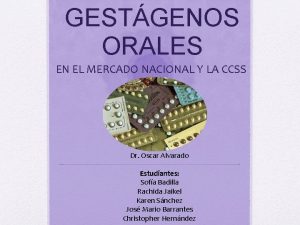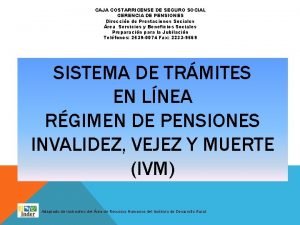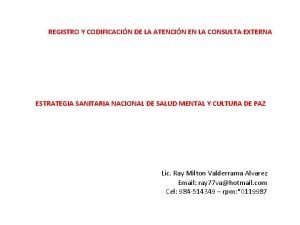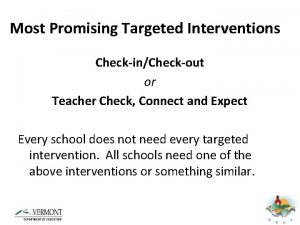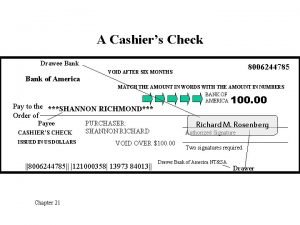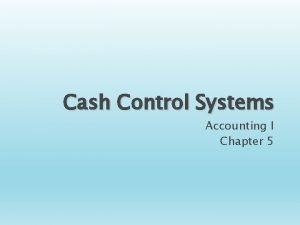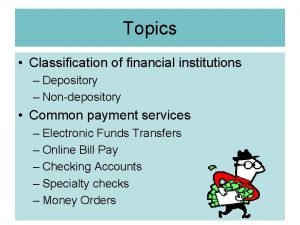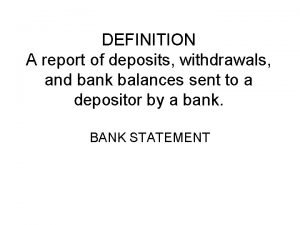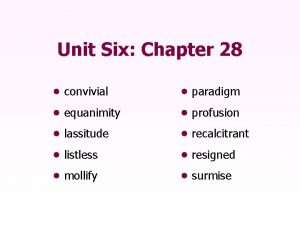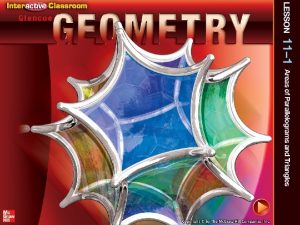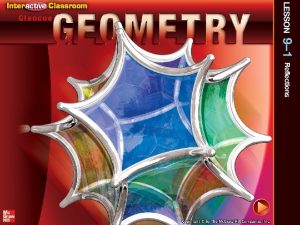FiveMinute Check over Chapter 3 CCSS ThenNow New































- Slides: 31


Five-Minute Check (over Chapter 3) CCSS Then/Now New Vocabulary Key Concept: Slope-Intercept Form Example 1: Write and Graph an Equation Example 2: Graph Linear Equations Example 3: Graph Linear Equations Example 4: Standardized Test Example 5: Real-World Example: Write and Graph a Linear Solution

Over Chapter 3 What is the slope of the line that passes through (– 4, 8) and (5, 2)? A. B. C. D.

Over Chapter 3 Suppose y varies directly as x and y = – 5 when x = 10. Which is a direct variation equation that relates x and y? A. y = 2 x B. C. y = – 2 x D.

Over Chapter 3 Find the next two terms in the arithmetic sequence – 7, – 4, – 1, 2, …. A. 4, 7 B. 1, 4 C. 5, 8 D. 3, 6

Over Chapter 3 Is the function represented by the table linear? Explain. A. Yes, both the x-values and the y-values change at a constant rate. B. Yes, the x-values increase by 1 and the y-values decrease by 1. C. No, the x-values and the y-values do not change at a constant rate. D. No, only the x-values increase at a constant rate.

Over Chapter 3 Out of 400 citizens randomly surveyed, 258 stated they supported building a dog park. If the survey was unbiased, how many of the city’s 5800 citizens can be expected not to support the dog park? A. 2059 B. 4000 C. 3741 D. 2580

Content Standards F. IF. 7 a Graph linear and quadratic functions and show intercepts, maxima, and minima. S. ID. 7 Interpret the slope (rate of change) and the intercept (constant term) of a linear model in the context of the data. Mathematical Practices 2 Reason abstractly and quantitatively. 8 Look for and express regularity in repeated reasoning. Common Core State Standards © Copyright 2010. National Governors Association Center for Best Practices and Council of Chief State School Officers. All rights reserved.

You found rates of change and slopes. • Write and graph linear equations in slope-intercept from. • Model real-world data with equations in slope -intercept form.

• slope-intercept form


Write and Graph an Equation Write an equation in slope-intercept form of the line with a slope of and a y-intercept of – 1. Then graph the equation. Slope-intercept form

Write and Graph an Equation Now graph the equation . Step 1 Plot the y-intercept (0, – 1). Step 2 The slope is . From (0, – 1), move up 1 unit and right 4 units. Plot the point. Step 3 Draw a line through the points. Answer:

Write an equation in slope-intercept form of the line whose slope is 4 and whose y-intercept is 3. A. y = 3 x + 4 B. y = 4 x + 3 C. y = 4 x D. y = 4

Graph Linear Equations Graph 5 x + 4 y = 8. Solve for y to write the equation in slope-intercept form. 5 x + 4 y = 8 5 x + 4 y – 5 x = 8 – 5 x Original equation Subtract 5 x from each side. 4 y = 8 – 5 x Simplify. 4 y = – 5 x + 8 8 – 5 x = 8 + (– 5 x) or – 5 x + 8 Divide each side by 4.

Graph Linear Equations Slope-intercept form Answer: Now graph the equation. Step 1 Plot the y-intercept (0, 2). Step 2 The slope is From (0, 2), move down 5 units and right 4 units. Draw a dot. Step 3 Draw a line connecting the points.

Graph 3 x + 2 y = 6. A. B. C. D.

Graph Linear Equations Graph y = – 7. Step 1 Plot the y-intercept (0, 7). Step 2 The slope is 0. Draw a line through the points with the y-coordinate 7. Answer:

Graph 5 y = 10. A. B. C. D.

Which of the following is an equation in slope-intercept form for the line shown in the graph? A. B. C. D.

Read the Test Item You need to find the slope and y-intercept of the line to write the equation. Solve the Test Item Step 1 The line crosses the y-axis at (0, – 3), so the y-intercept is – 3. The answer is either B or D.

Step 2 To get from (0, – 3) to (1, – 1), go up 2 units and 1 unit to the right. The slope is 2. Step 3 Write the equation. y = mx + b y = 2 x – 3 Answer: The answer is B.

Which of the following is an equation in slopeintercept form for the line shown in the graph? A. B. C. D.

Write and Graph a Linear Equation HEALTH The ideal maximum heart rate for a 25 -year-old exercising to burn fat is 117 beats per minute. For every 5 years older than 25, that ideal rate drops 3 beats per minute. A. Write a linear equation to find the ideal maximum heart rate for anyone over 25 who is exercising to burn fat.

Write and Graph a Linear Equation

Write and Graph a Linear Equation B. Graph the equation. The graph passes through (0, 117) with a slope of Answer:

Write and Graph a Linear Equation C. Find the ideal maximum heart rate for a 55 -year-old person exercising to burn fat. The age 55 is 30 years older than 25. So, a = 30. Ideal heart rate equation Replace a with 30. Simplify. Answer: The ideal maximum heart rate for a 55 -yearold person is 99 beats per minute.

A. The amount of money spent on Christmas gifts has increased by an average of $150, 000 ($0. 15 million) per year since 1986. Consumers spent $3 million in 1986. Write a linear equation to find the average amount D spent for any year n since 1986. A. D = 0. 15 n B. D = 0. 15 n + 3 C. D = 3 n D. D = 3 n + 0. 15

B. The amount of money spent on Christmas gifts has increased by an average of $150, 000 ($0. 15 million) per year since 1986. Consumers spent $3 million in 1986. Graph the equation. A. B. C. D.

C. The amount of money spent on Christmas gifts has increased by an average of $150, 000 ($0. 15 million) per year since 1986. Consumers spent $3 million in 1986. Find the amount spent by consumers in 1999. A. $5 million B. $3 million C. $4. 95 million D. $3. 5 million

 Ccss app
Ccss app Norgyl ccss
Norgyl ccss Ccss
Ccss Gerencia de pensiones
Gerencia de pensiones Ccss splash
Ccss splash Test de tamizaje para adolescentes de la ccss
Test de tamizaje para adolescentes de la ccss Jpams ccss
Jpams ccss Behavior check in check out sheet
Behavior check in check out sheet Check in check out forms
Check in check out forms Check in check out
Check in check out Check in check out system
Check in check out system Where is the check number on a cashier's check
Where is the check number on a cashier's check Starburst method
Starburst method Checkin checkout system
Checkin checkout system Check in and check out intervention
Check in and check out intervention The fan blade is speeding up. what are the signs of
The fan blade is speeding up. what are the signs of How to sign a check over
How to sign a check over Check my progress vocabulary check
Check my progress vocabulary check Non depository institutions
Non depository institutions Over the mountains over the plains
Over the mountains over the plains Siach reciting the word over and over
Siach reciting the word over and over Handing over and taking over the watch
Handing over and taking over the watch Chapter 16 toward a new heaven and a new earth
Chapter 16 toward a new heaven and a new earth An endorsement consisting only of the endorser's signature
An endorsement consisting only of the endorser's signature List six reasons why a bank may dishonor a check.
List six reasons why a bank may dishonor a check. Yun.ir refah new check
Yun.ir refah new check Industrialism definition world history
Industrialism definition world history Paradigm. meaning
Paradigm. meaning Ten words in context chapter 3
Ten words in context chapter 3 Improving vocabulary skills 5th edition
Improving vocabulary skills 5th edition Chapter 12 banking procedures and services vocabulary check
Chapter 12 banking procedures and services vocabulary check Chapter 16 sentence check 2
Chapter 16 sentence check 2

